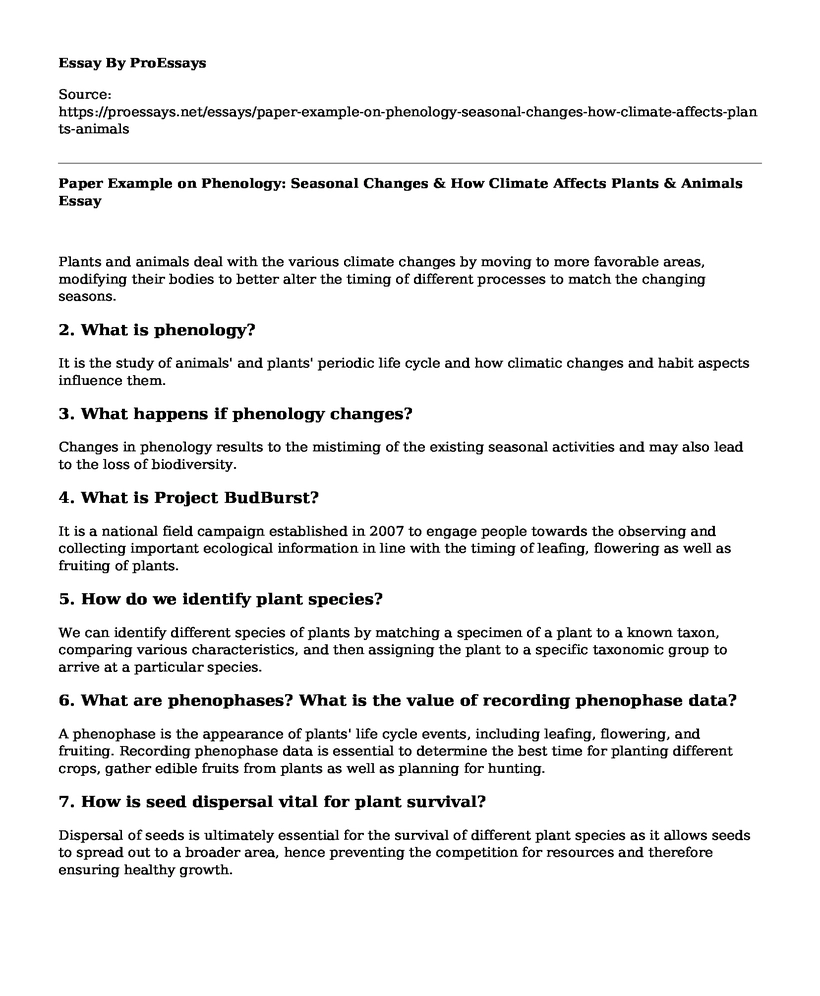Plants and animals deal with the various climate changes by moving to more favorable areas, modifying their bodies to better alter the timing of different processes to match the changing seasons.
2. What is phenology?
It is the study of animals' and plants' periodic life cycle and how climatic changes and habit aspects influence them.
3. What happens if phenology changes?
Changes in phenology results to the mistiming of the existing seasonal activities and may also lead to the loss of biodiversity.
4. What is Project BudBurst?
It is a national field campaign established in 2007 to engage people towards the observing and collecting important ecological information in line with the timing of leafing, flowering as well as fruiting of plants.
5. How do we identify plant species?
We can identify different species of plants by matching a specimen of a plant to a known taxon, comparing various characteristics, and then assigning the plant to a specific taxonomic group to arrive at a particular species.
6. What are phenophases? What is the value of recording phenophase data?
A phenophase is the appearance of plants' life cycle events, including leafing, flowering, and fruiting. Recording phenophase data is essential to determine the best time for planting different crops, gather edible fruits from plants as well as planning for hunting.
7. How is seed dispersal vital for plant survival?
Dispersal of seeds is ultimately essential for the survival of different plant species as it allows seeds to spread out to a broader area, hence preventing the competition for resources and therefore ensuring healthy growth.
8. What are the different types of seed dispersal?
There are five significant forms of seed dispersal, including wind, water, gravity, animals, and ballistic dispersals.
9. How is seed dispersal related to changing climates?
Climate change such as shifting winds can cause seeds to land in unfavorable growing conditions while complete lack of may prevent plants that depend on wind to disperse. Importantly global warming may also cause seeds to disperse and flower early.
10. What are some of the challenges of collecting long-term data sets?
Among the main challenges for collecting long-term environmental data sets include difficulty maintaining quality and maintaining a line of communication with all the long-term data.
11. How did plant bloom time change between the 1850s and today?
Due to the climate change caused by the ongoing global warming, plant bloom time has since changed significantly, as most of the plants experience flower bloom between one to three months earlier today than how it usually was in the 1850s.
12. What variables can explain the differences in bloom time?
Various factors such as temperature, availability of water and soil nutrients, availability of pollinators, and photoperiod determine the differences in bloom time.
13. How do NASA data and satellite imagery help us understand and interpret the
Phenology data that we collect through Project BudBurst?
The satellite data collected by NASA help us understand and interpret the phenology data collected because they can measure the number of elements such as sunlight absorbed by the plants.
14. How are plants responding to changing climates?
In response to climate changes, many plants shift their distributions downwards, searching for warmer and lower elevations.
Cite this page
Paper Example on Phenology: Seasonal Changes & How Climate Affects Plants & Animals. (2023, May 21). Retrieved from https://proessays.net/essays/paper-example-on-phenology-seasonal-changes-how-climate-affects-plants-animals
If you are the original author of this essay and no longer wish to have it published on the ProEssays website, please click below to request its removal:
- Essay Example on the Climate Change
- Perdue Chicken Factory Essay
- Effects of Noise Pollution Essay
- Essay Sample on Business Issues
- Essay Example on Air Pollution: Comparing US & India Strategies
- Essay on Second Responders in Hurricane Katrina: Examining the Role of the EPA and DOD
- West Virginia Floods 2016 & Hurricane Maria 2017: Disaster Analysis & Mitigation - Essay Sample







